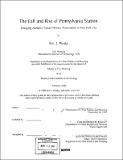The fall and rise of Pennsylvania Station : changing attitudes toward historic preservation in New York City
Author(s)
Plosky, Eric J. (Eric Jay), 1977-
DownloadFull printable version (6.405Mb)
Other Contributors
Massachusetts Institute of Technology. Dept. of Urban Studies and Planning.
Advisor
Robert M. Fogelson.
Terms of use
Metadata
Show full item recordAbstract
In 1910, the Pennsylvania Railroad constructed Pennsylvania Station, its New York City terminal. Built and designed as a "monumental gateway," an important civic structure as well as a transportation hub, the station became an important part of New York's urban fabric. Its success inspired the United States government to construct the adjacent Farley Post Office as an architectural and functional complement to Penn Station. By 1963, changing economic conditions and the evolving nature of passenger transportation prompted the Pennsylvania Railroad to announce plans to sell development rights on the Penn Station site. The station would be demolished and replaced with a new Madison Square Garden complex; the railroad would create a new underground "Penn Station" beneath the Garden. These plans prompted tremendous public and editorial outcry on a scale never before seen, thus beginning the historic-preservation movement in New York City. Although in 1963 the city had no authority to intervene, and Penn Station was indeed demolished as planned, Mayor Robert Wagner in 1965 signed New York City's Landmarks Law, establishing the Landmarks Preservation Commission. The Commission had the power to protect designated landmarks from demolition. By the 1990s, the city's attitude toward historic preservation had come full circle, as vividly illustrated by new plans to renovate a portion of the Farley Post Office as a new Penn Station waiting area and concourse. This thesis uses the example of Penn Station's fall and rise to chronicle and analyze New York's change in attitude toward historic preservation.
Description
Thesis (M.C.P.)--Massachusetts Institute of Technology, Dept. of Urban Studies and Planning, February 2000. "February 2000." Vita. Includes bibliographical references (p. 73-79).
Date issued
2000Department
Massachusetts Institute of Technology. Department of Urban Studies and PlanningPublisher
Massachusetts Institute of Technology
Keywords
Urban Studies and Planning.